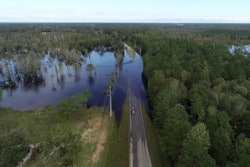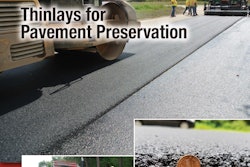 One-half of Wisconsin’s major locally and state-maintained roads are in poor or mediocre condition
One-half of Wisconsin’s major locally and state-maintained roads are in poor or mediocre conditionRoads and bridges that are deteriorated, congested or lack some desirable safety features cost Wisconsin drivers $6.8 billion statewide each year, due to higher vehicle operating costs, traffic crashes and congestion-related delays, according to TRIP, a national transportation research group based in Washington, D.C.
That figures out to an average of $2,321 paid per driver in the state’s largest urban areas, according to the new report released Tuesday.
“Increased investment in transportation improvements at the local, state and federal levels could relieve traffic congestion, improve road, bridge and transit conditions, boost safety, and support long-term economic growth in Wisconsin,” the report finds.
The report, “Wisconsin Transportation by the Numbers: Meeting the State’s Need for Safe, Smooth and Efficient Mobility,” finds that throughout Wisconsin, one-half of major locally and state-maintained roads are in poor or mediocre condition and nine percent of locally and state-maintained bridges are structurally deficient.
The report also finds that Wisconsin’s major urban roads are becoming increasingly congested, causing significant delays and choking commuting and commerce, a press release says.
“Driving on roads in Wisconsin costs the state’s drivers $6.8 billion per year in the form of extra vehicle operating costs (VOC) as a result of driving on roads in need of repair, lost time and fuel due to congestion-related delays, and the cost of traffic crashes in which roadway features likely were a contributing factor,” the report says.
Traffic congestion in Wisconsin’s major urban areas is worsening, causing up to 41 annual hours of delay for some motorists and costing the state’s drivers a total of $1.9 billion each year in lost time and wasted fuel, the report says.
The TRIP report calculates the cost to drivers of insufficient roads in the Eau Claire, Green Bay-Appleton-Oshkosh, Madison, Milwaukee and Wausau areas. A breakdown of the costs per motorist in each area, along with a statewide total, is here.

To see news releases providing further details on each of those metro areas, click here.
Driving on Wisconsin roads that are deteriorated, congested and that lack some desirable safety features costs Wisconsin drivers a total of $6.8 billion each year.
TRIP has calculated the cost to the average motorist in the state’s largest urban areas in the form of additional vehicle operating costs (VOC) as a result of driving on rough roads, the cost of lost time and wasted fuel due to congestion, and the financial cost of traffic crashes.
The TRIP report finds:
- 31 percent of Wisconsin’s major locally and state-maintained roads are in poor condition
- 19 percent are in mediocre condition
- 17 percent are rated in fair condition
- and the remaining 33 percent are in good condition
 Due to inadequate state and local funding, half of major locally and state-maintained roads and highways in Wisconsin are in poor or mediocre condition.
Due to inadequate state and local funding, half of major locally and state-maintained roads and highways in Wisconsin are in poor or mediocre condition.“Until state elected officials are able to agree on long-term, sustainable transportation funding, Wisconsin will be unable to meet mounting needs on our local roads and state highways,” says Daniel J. Fedderly, executive director of the Wisconsin County Highway Association. “The current funding system causes us to be reactive, responding from one crisis to the next. We would much rather be working proactively on a shared sense of vision that can move our communities and state forward, and represent our citizens across Wisconsin.”
Nine percent of Wisconsin’ bridges are structurally deficient, with significant deterioration to the bridge deck, supports or other major components.
Traffic fatality rate below national average
Traffic crashes in Wisconsin claimed the lives of more than 2,800 between 2012 and 2016. Wisconsin’s overall traffic fatality rate of 0.95 fatalities per 100 million vehicle miles of travel is lower than the national average of 1.18.
The fatality rate on Wisconsin’s non-interstate rural roads is nearly two and a half times that on all other roads in the state (1.43 fatalities per 100 million vehicle miles of travel vs. 0.61). The financial impact of traffic crashes costs the state’s drivers $1.8 billion annually.
The efficiency and condition of Wisconsin’s transportation system, particularly its highways, is critical to the health of the state’s economy.
Wisc. infrastructure supports more than 64,000 full-time jobs across all sectors
Annually, $580 billion in goods are shipped to and from sites in Wisconsin, mostly by trucks, relying heavily on the state’s network of roads and bridges. Increasingly, companies are looking at the quality of a region’s transportation system when deciding where to relocate or expand.
Regions with congested or poorly maintained roads may see businesses relocate to areas with a smoother, more efficient and more modern transportation system.
The design, construction and maintenance of transportation infrastructure in Wisconsin supports more than 64,000 full-time jobs across all sectors of the state economy.
“Driving on deficient Wisconsin roads comes with a $6.8 billion price tag for the state’s motorists,” says Will Wilkins, TRIP’s executive director. “Adequate funding for the state’s transportation system would allow for smoother roads, more efficient mobility, enhanced safety, and economic growth opportunities while saving Wisconsin’s drivers time and money.”
To see the entire report, click here.












